APAC Cosmetic Packaging Market Size
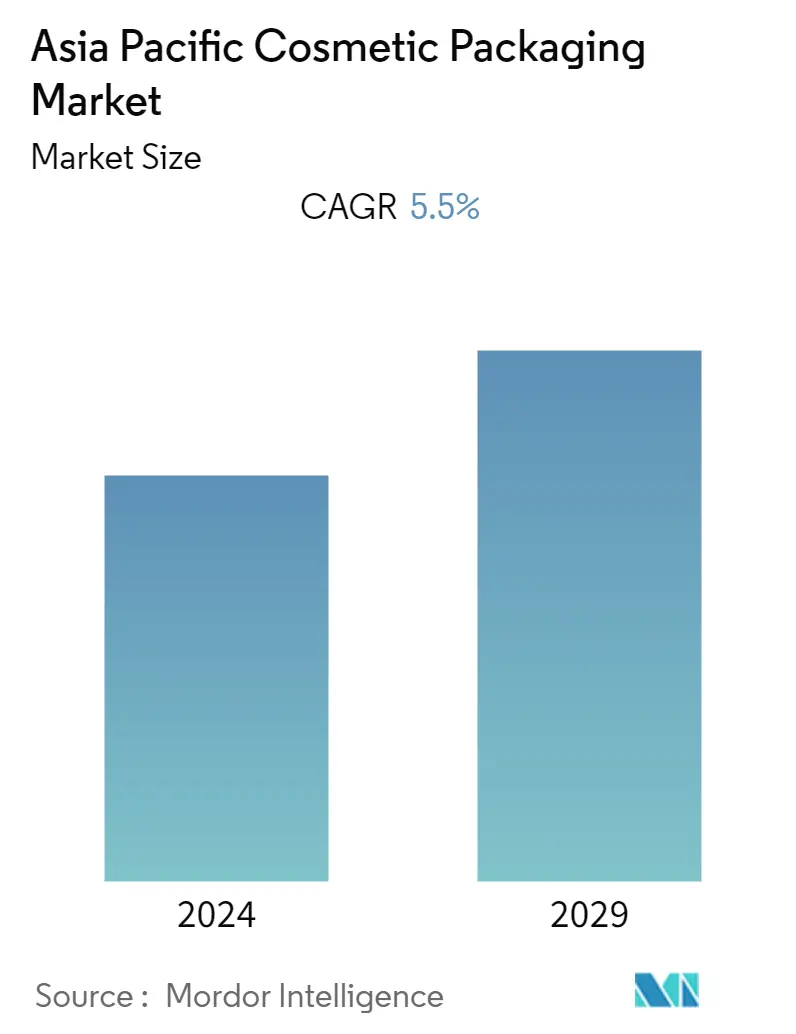
| Study Period | 2019 - 2029 |
| Base Year For Estimation | 2023 |
| Forecast Data Period | 2024 - 2029 |
| Historical Data Period | 2019 - 2022 |
| CAGR | 5.50 % |
| Market Concentration | Medium |
Major Players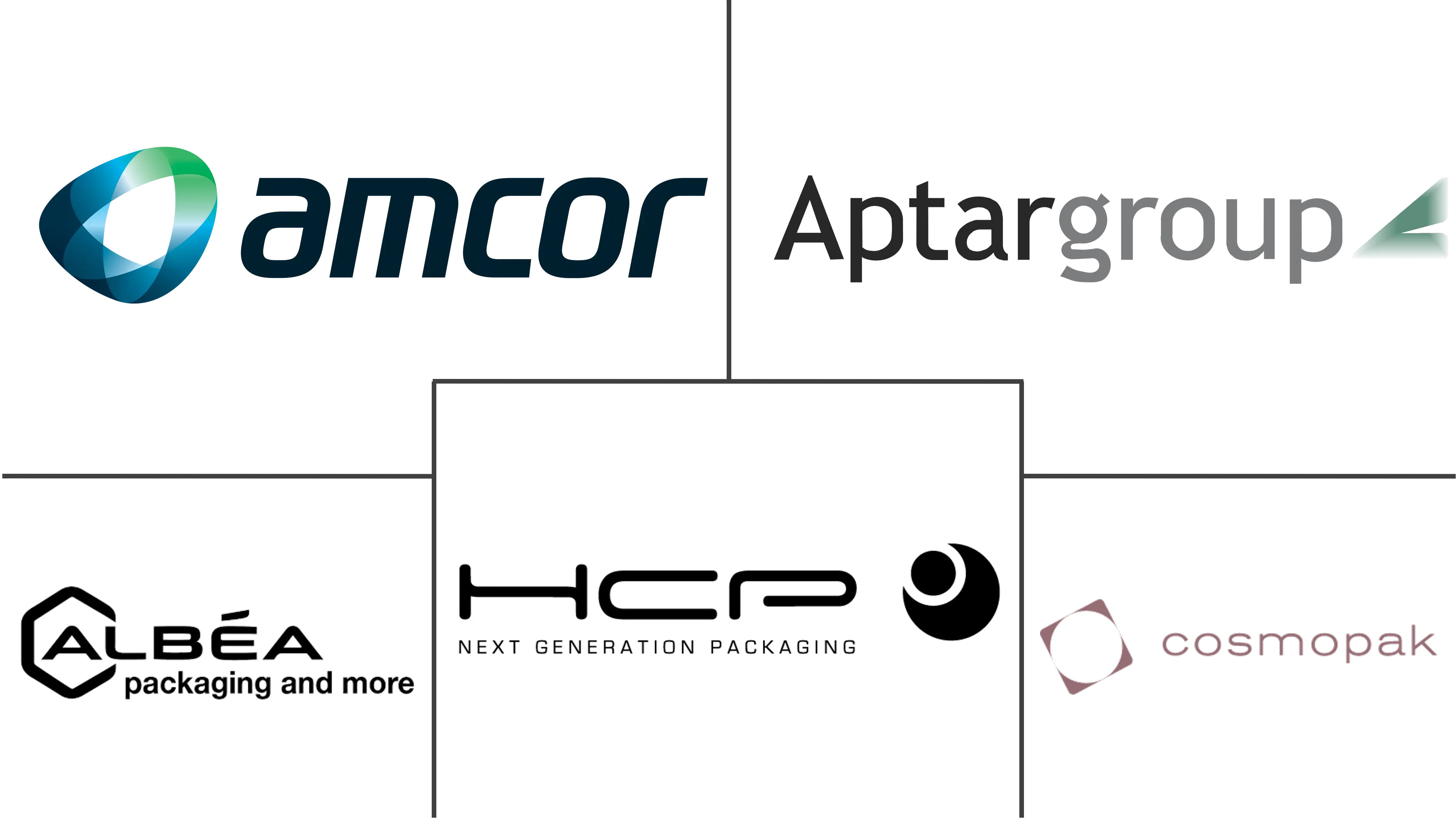
*Disclaimer: Major Players sorted in no particular order |
APAC Cosmetic Packaging Market Analysis
The Asia-Pacific cosmetics packaging market is expected to register a CAGR of 5.5% over the forecast period. The market size reflects the value of packaging used for cosmetics across the countries in Asia-Pacific. The cosmetics industry has the most varied packaging requirements among the other sectors. The materials used also vary, including different metals, paper, glass, and plastics. These materials are used to make containers, pouches, cartons, boxes, tubes, droppers, ampoules, and various types of flexible packaging.
- The region's cosmetic industry is driven by increasing dynamic customer bases in economies such as China, India, Japan, and Indonesia. Factors such as growing beauty consciousness among consumers, affordable cosmetics, and e-retailing are increasing the consumption of cosmetic products in the region.
- Market players also focus on producing innovative and attractive packaging to make their products stand out compared to their competitors. Also, factors such as rising disposable incomes, affordable cosmetic products, the growing popularity of skin care products made with natural and organic ingredients, and surging e-commerce are driving the demand for the cosmetics packaging market in Asia-Pacific.
- The Asia-Pacific region is anticipated to drive packaging volumes in the cosmetics industry, driven by rising disposable incomes and the intense penetration of smaller pack sizes in the form of single-use flexible plastics, which are famous for their immediate affordability. Socio-demographic changes in the region positively impact the demand for natural ingredients for cosmetics and related products. The region's aging populations (in South Korea, China, and Japan) are increasing the demand for natural ingredients with active properties, such as anti-aging.
- Paper-based cosmetics packaging has been seeing high growth in the Asia-Pacific market. Many Asian and global brands are launching their products in paper packaging to meet the growing consumer appetite for sustainable packaging products.
- Paper-based packaging is predominantly used in secondary and tertiary packaging. Most cosmetic formulas contain around 70% to 95% water; therefore, paper is usually not used as primary packaging for cosmetic products. However, many companies are launching cosmetic products that use paper-based, innovative primary packaging solutions. For instance, in November 2021, WOW Skin Science, a personal care brand, launched its bestselling Vitamin C Face Wash in the company's first-ever paper tube packaging. The paper used in the packaging is Forest Stewardship Council certified, and it has a high burst strength and low COBB value, indicating it is strong and stable even in humid conditions.
- The spread of COVID-19 negatively impacted the market due to disruptions in the supply chain due to extended factory closures in the region. It was difficult for bottle, carton, box, and packaging manufacturers to provide these products to cosmetics companies compared to the standard scenario.
However, growing sustainability concerns and increasing consumer awareness regarding the ill effects of plastic on the planet, health, and environment are expected to hinder market growth, although many cosmetic players are still using plastic packaging as plastic is one of the most preferred materials for cosmetics packaging. Also, plastic, in its numerous forms for primary containers, secondary flexible pouches, caps and closures, and nozzles, is one of the primary packaging materials used by the cosmetic market. This is anticipated to fuel growth for the market.
APAC Cosmetic Packaging Market Trends
This section covers the major market trends shaping the APAC Cosmetic Packaging Market according to our research experts:
Plastic Packaging is Expected to Drive the Market Growth
- Plastic is one of the most commonly used and preferred materials for cosmetic packaging. Numerous cosmetic products on the market come in plastic bottles and containers, owing to the material's easy molding, structuring, design capability, and protection.
- Plastic bottles and containers are the most popular types of primary packaging in the cosmetics industry. They have held a large share of the market for the past five years without any competition.According to a National Geographic study, plastic packaging is used 120 times more in cosmetic packaging today than it was in 1960.
- Plastic packaging is used in multiple personal care products, such as cosmetics, toiletries, and more. Also, sophisticated cosmetics, such as special oils, vitamins, and herbal compounds, need high protection from light and contamination. These products also require an extended shelf life. Thus, flexible and multi-layer barrier plastic packaging films are used.
- In March 2021, cosmetics brand Garnier stated that it aims to stop using virgin plastic for all packaging by 2025. Also, the company indicated that its factories and manufacturing units would become carbon-neutral by 2025. The company would use reusable, recyclable, or compostable materials in all packaging, saving 37,000 metric tons of plastic annually under its sustainability program, Garnier Green Beauty.
- Chinese beauty brands are innovating sustainable cosmetic packaging solutions. For instance, in July 2022, Top Cosmetics launched its core facial cream products with packaging made from Eastman's mass-balanced Cristal Renew copolyester with 50% certified recycled content. The new packaging is developing close collaboration in the value chain between onTop, WWP Beauty, and molecular recycling company Eastman.
Additionally, according to Plast India, the demand for polypropylene (PP) is on the higher side and was around 6.1 million metric tons in 2021-2022, while high-density polyethylene (HDPE) and polyvinyl chloride (PVC) stood at 2.9 and 2.8 million metric tons, respectively.
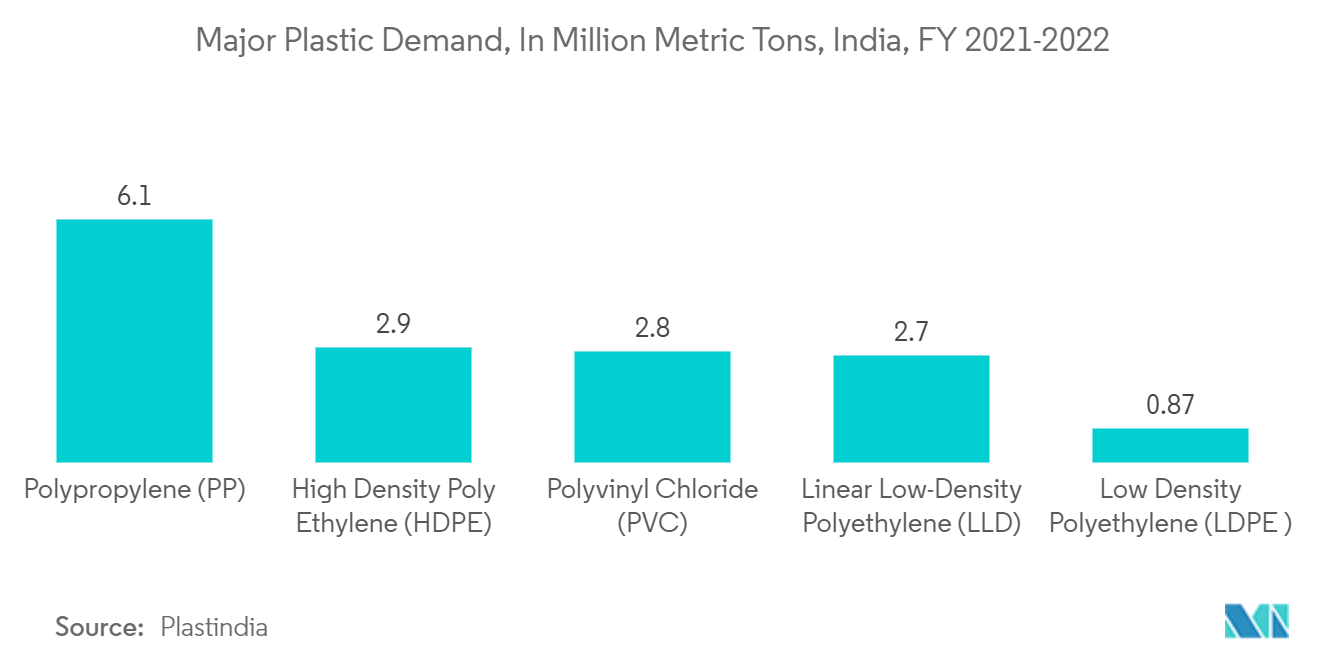
China is Expected to Register Significant Growth
- The cosmetics market in China has been one of the fastest-growing sectors in the last few years, benefiting from an increasingly engaged consumer base, which is augmenting the growth of the market studied.
- Consumer spending on cosmetics continues to grow, facilitating the trend toward adopting processed, packaged, and expensive products. Skincare and decorative cosmetics are growing soundly, with facial care and medical skincare witnessing robust demand. Moreover, growth potential is also provided by anti-aging products and those intended to protect against environmental pollution.
- China's State Administration for Market Regulation's China GB 23350-2021 "Requirements of Restricting Excessive Package-Foods and Cosmetics" announced in March 2021 that September 2021 would be an amendment to existing standards released in 2009, giving cosmetics companies two years to redesign their product presentation.The new Chinese standard targeted at controlling excessive packaging is planned to come into force in September 2023. This is expected to be a challenge for the cosmetics sector in the short term but is anticipated to promote sustainability in the long run.
- The inevitability of the sustainable beauty trend is pushing companies in the cosmetic manufacturing industry to develop more eco-solutions for consumers in the country. Moreover, due to government regulations, many Chinese cosmetics brands have been shifting to sustainable packaging. For instance, in July 2022, onTop launched packaging made with Eastman Cristal Renew copolyester with 50% certified recycled content.
- Owing to the increasing demand for paper-based packaging products, global companies are also investing in China. For instance, in June 2021, Huhtamaki completed the acquisition of Jiangsu Hihio-Art Packaging Co. Ltd., a China-based manufacturer of paper bags, wraps, and folding carton packaging. Developments like these are also expected to occur in paper packaging for cosmetic packaging.
- Also, China is the world's largest plastic producer by far, accounting for nearly one-third of global plastic production. According to the National Bureau of Statistics of China, the production of plastic products in December 2021 was 7.95 million metric tons, the highest since January 2020.
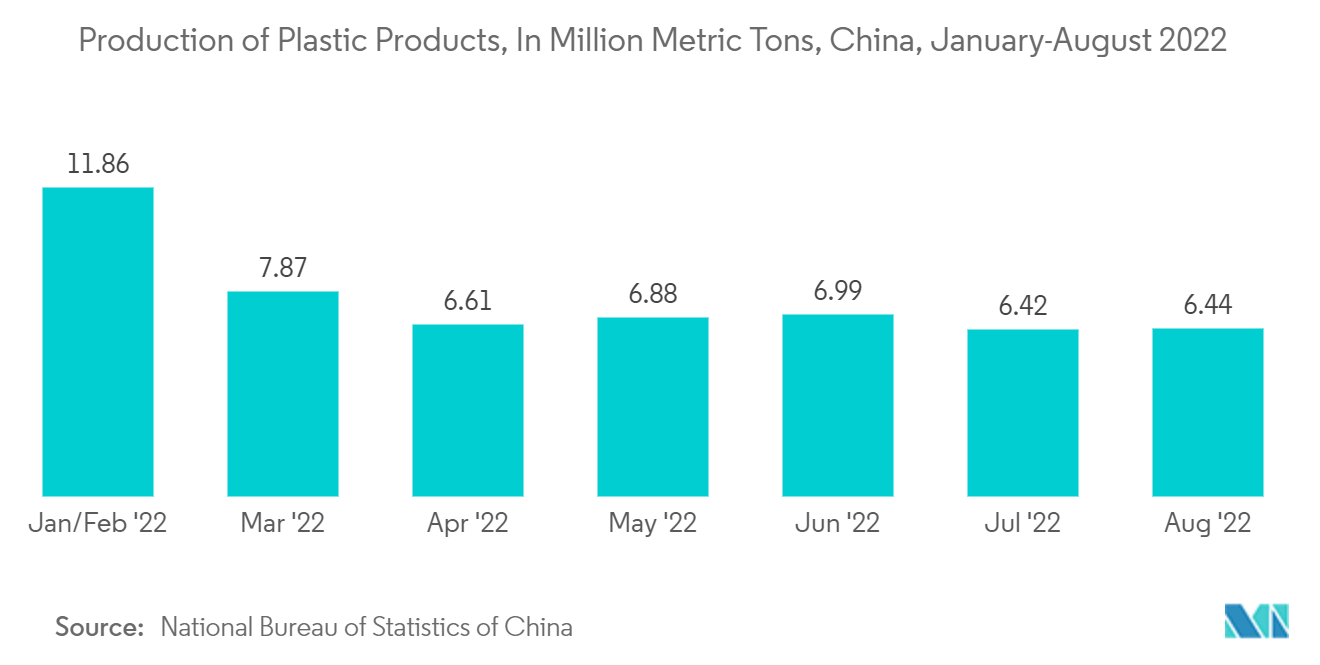
APAC Cosmetic Packaging Industry Overview
The Asia-Pacific Cosmetic Packaging Market is moderately competitive, accounting for the healthy competition from established players and new entrants. The industry's established players are leveraging their manufacturing capabilities and R&D to drive innovation and sustain their competitive position in the market.
In May 2022, Carlyle, a global investment firm, announced it agreed to acquire a 100% stake in HCP Packaging, a leading company in the design, development and manufacture of cosmetic packaging. Carlyle would leverage its deep sector experience in the consumer and manufacturing industries for supporting HCP as it aims to continue to scale its operations and grow its customer base across the world.
In January 2022, Kao Corporation aimed to fulfill material recycling of cosmetics bottles that are made from plastic. It is implementing field testing aimed at recycling used cosmetics bottles that have been collected and transforming them back into new bottles. The company's plan involved collecting cosmetic bottles for field testing of material recycling to turn used cosmetics bottles into new cosmetics bottles.
APAC Cosmetic Packaging Market Leaders
-
Amcor PLC
-
Albéa Group
-
Cosmopak Corporation
-
Hcp Packaging Co., Ltd.
-
AptarGroup Inc.
*Disclaimer: Major Players sorted in no particular order
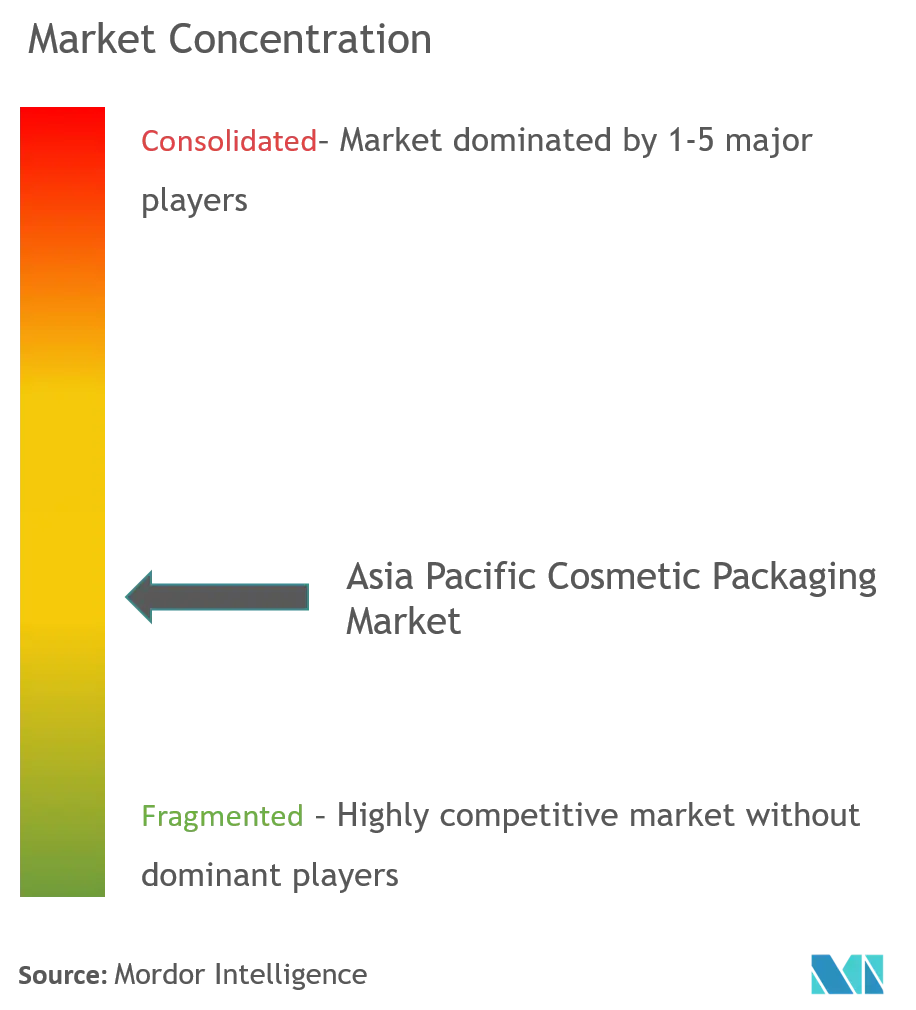
APAC Cosmetic Packaging Market News
- June 2022: Watsons partnered with L'Oréal to roll out the 'Beauty for the Future' recycling campaign to widen its sustainability impact. The company is looking to expand its green credentials, extending the recycling program to Hong Kong.
- June 2022: SGD Pharma, a leader in pharmaceutical-grade molded glass vials, intends to expand globally in the cosmetics and beauty segment. The company's beauty and care division is already the Asia Pacific market leader in this segment, supplying both global and local beauty brands through their factory in Zhanjiang, China-based.
APAC Cosmetic Packaging Market Report - Table of Contents
1. INTRODUCTION
- 1.1 Study Assumptions and Market Definition
- 1.2 Scope of the Study
2. RESEARCH METHODOLOGY
3. EXECUTIVE SUMMARY
4. MARKET INSIGHTS
- 4.1 Market Overview
- 4.2 Industry Value Chain Analysis
-
4.3 Industry Attractiveness - Porter's Five Forces Analysis
- 4.3.1 Bargaining Power of Suppliers
- 4.3.2 Bargaining Power of Buyers
- 4.3.3 Threat of New Entrants
- 4.3.4 Threat of Substitute Products
- 4.3.5 Intensity of Competitive Rivalry
- 4.4 Assessment of COVID-19 Impact on the Market
- 4.5 Overview of the Global Cosmetic Packaging Market
5. MARKET DYNAMICS
-
5.1 Market Drivers
- 5.1.1 Increasing Consumption of Cosmetic Products in the Region
- 5.1.2 Increasing Focus on Innovation and Attractive Packaging
-
5.2 Market Restraints
- 5.2.1 Growing Sustainability Concerns
6. MARKET SEGMENTATION
-
6.1 Material Type
- 6.1.1 Plastic
- 6.1.2 Glass
- 6.1.3 Metal
- 6.1.4 Paper
-
6.2 Product Type
- 6.2.1 Plastic Bottles and Containers
- 6.2.2 Glass Bottles and Containers
- 6.2.3 Metal Containers
- 6.2.4 Folding Cartons
- 6.2.5 Corrugated Boxes
- 6.2.6 Tubes and Sticks
- 6.2.7 Caps and Closures
- 6.2.8 Pump and Dispenser
- 6.2.9 Droppers
- 6.2.10 Ampoules
- 6.2.11 Flexible Plastic Packaging
-
6.3 Cosmetic Type
- 6.3.1 Color Cosmetics
- 6.3.2 Skin Care
- 6.3.3 Men's Grooming
- 6.3.4 Deodrants
- 6.3.5 Other Cosmetic Types (Fragrances, Depilatories, Baby and Child Care, and Sun Care)
-
6.4 Country
- 6.4.1 China
- 6.4.2 Japan
- 6.4.3 South Korea
- 6.4.4 India
- 6.4.5 Indonesia
- 6.4.6 Rest of Asia-Pacific
7. COMPETITIVE INTELLIGENCE
-
7.1 Company Profiles
- 7.1.1 Albea SA
- 7.1.2 HCP Packaging Co. Ltd
- 7.1.3 RPC Group PLC (Berry Global Group)
- 7.1.4 DS Smith PLC
- 7.1.5 Graham Packaging L.P.
- 7.1.6 AptarGroup Inc.
- 7.1.7 Amcor PLC
- 7.1.8 Cosmopak Ltd
- 7.1.9 Quadpack Industries SA
- 7.1.10 Gerresheimer AG
- *List Not Exhaustive
8. INVESTMENT ANALYSIS
9. FUTURE OF THE MARKET
** Subject To AvailablityAPAC Cosmetic Packaging Industry Segmentation
Asia Pacific Cosmetic Packaging Market is Segmented By Material Type (Plastic, Glass, Metal, Paper), Product Type (Plastic Bottles and Containers, Glass Bottles and Containers, Metal Containers, Folding Cartons, Corrugated Boxes, Tubes and Sticks, Caps and Closures, Pump and Dispenser, Droppers, Ampoules, Flexible Plastic Packaging), Cosmetic Type (Color Cosmetics, Skin Care, Men's Grooming, Deodorants), and Country (China, Japan, South Korea, India, Indonesia, Rest of Asia Pacific).
The market sizes and forecasts are provided in terms of value (in USD million) for all the above segments.
| Material Type | Plastic |
| Glass | |
| Metal | |
| Paper | |
| Product Type | Plastic Bottles and Containers |
| Glass Bottles and Containers | |
| Metal Containers | |
| Folding Cartons | |
| Corrugated Boxes | |
| Tubes and Sticks | |
| Caps and Closures | |
| Pump and Dispenser | |
| Droppers | |
| Ampoules | |
| Flexible Plastic Packaging | |
| Cosmetic Type | Color Cosmetics |
| Skin Care | |
| Men's Grooming | |
| Deodrants | |
| Other Cosmetic Types (Fragrances, Depilatories, Baby and Child Care, and Sun Care) | |
| Country | China |
| Japan | |
| South Korea | |
| India | |
| Indonesia | |
| Rest of Asia-Pacific |
APAC Cosmetic Packaging Market Research FAQs
What is the current Asia Pacific Cosmetic Packaging Market size?
The Asia Pacific Cosmetic Packaging Market is projected to register a CAGR of 5.5% during the forecast period (2024-2029)
Who are the key players in Asia Pacific Cosmetic Packaging Market?
Amcor PLC, Albéa Group, Cosmopak Corporation, Hcp Packaging Co., Ltd. and AptarGroup Inc. are the major companies operating in the Asia Pacific Cosmetic Packaging Market.
What years does this Asia Pacific Cosmetic Packaging Market cover?
The report covers the Asia Pacific Cosmetic Packaging Market historical market size for years: 2019, 2020, 2021, 2022 and 2023. The report also forecasts the Asia Pacific Cosmetic Packaging Market size for years: 2024, 2025, 2026, 2027, 2028 and 2029.
Asia Pacific Cosmetic Packaging Industry Report
Statistics for the 2024 Asia Pacific Cosmetic Packaging market share, size and revenue growth rate, created by Mordor Intelligence™ Industry Reports. Asia Pacific Cosmetic Packaging analysis includes a market forecast outlook to 2029 and historical overview. Get a sample of this industry analysis as a free report PDF download.



